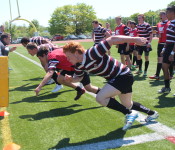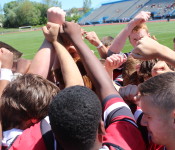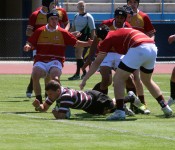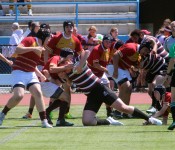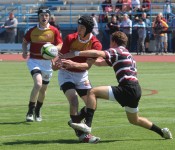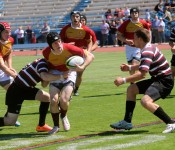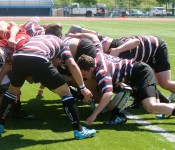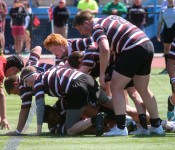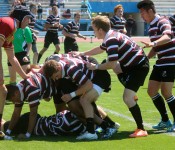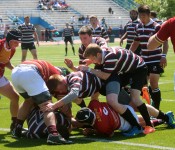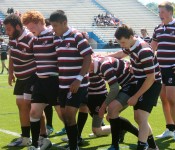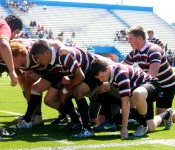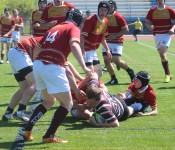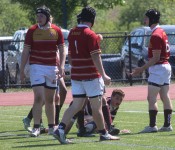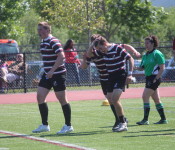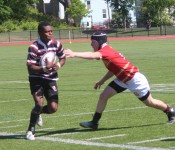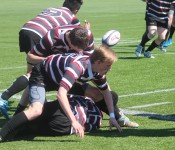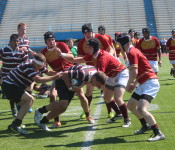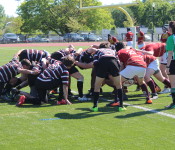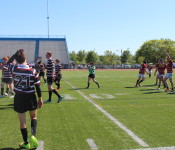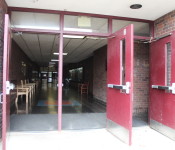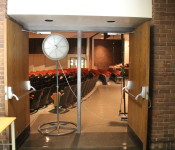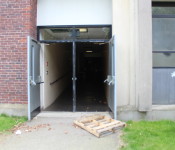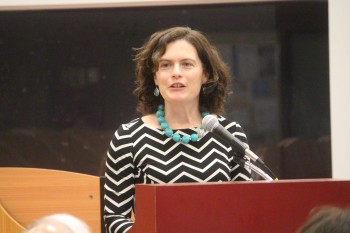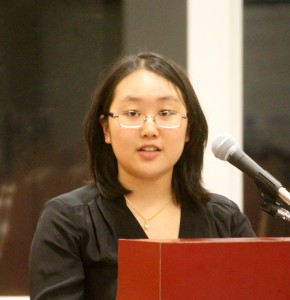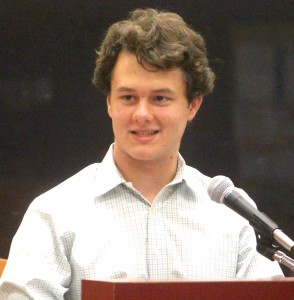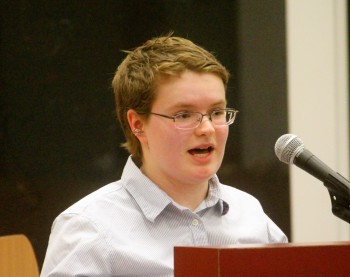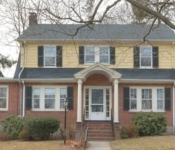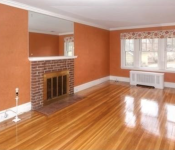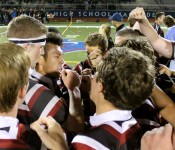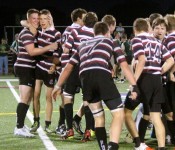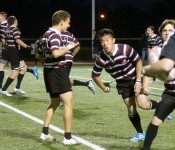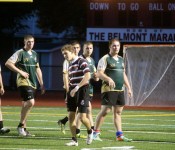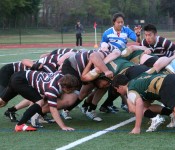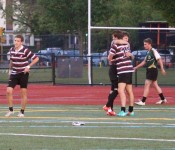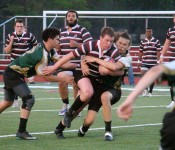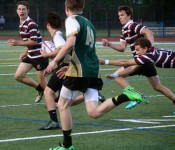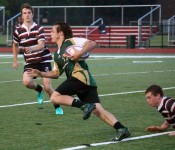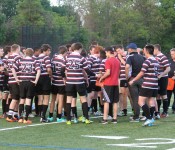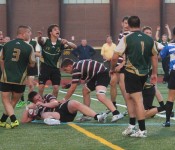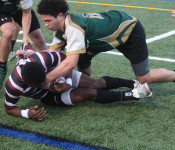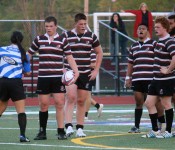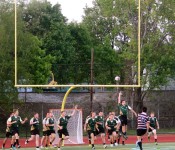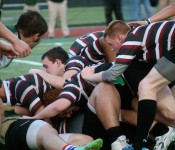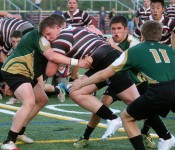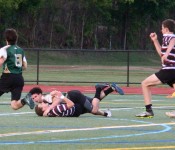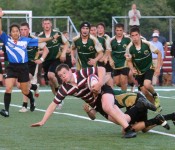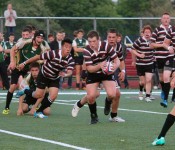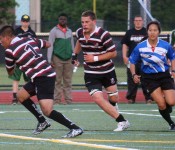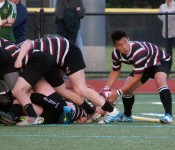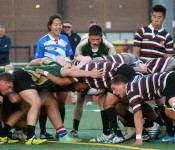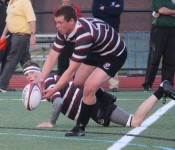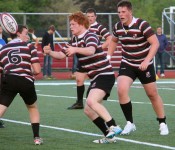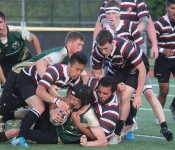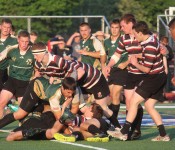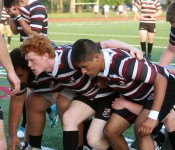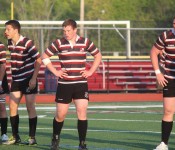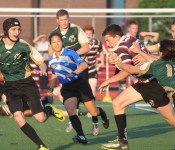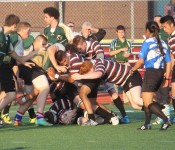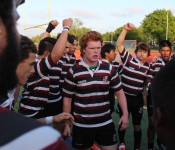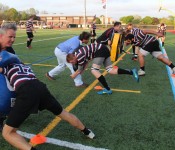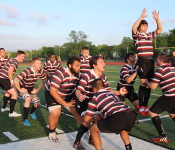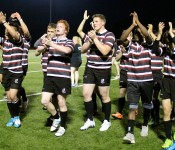Photo: The boys up front, the core of the Belmont High School Rugby Club that held its own against undefeated Boston College High.
The 26 Belmont High School Rugby Club players gathered in a circle, after throwing in their soul and heart into every minute of the 70 played in the state championship game held Saturday, May 23, in Worcester.
In a classic battle that left bodies bruised and, in the case of senior back row/center Luke Perrotta, a jersey soaked in blood, Belmont were the equal of an undefeated and mostly untested Boston College High School club squad on the pitch on a breezy, warm afternoon.
Equal in all but one category, the score. In a game in which they honored the tradition built of past teams and a championship earned two years ago, the players walked off the ground beaten by the Eagles, 26-10.
But in the eyes of Belmont’s head coach Greg Bruce, there was no shame in the fight the team displayed on the biggest stage of the season.
“There’s nothing that takes away from the season that your had, the work that you put in, the bonds that you made out here this season. These bonds that you make in rugby can not be broken,” Bruce told his senior-laden team.
“Every day you had this jersey on, you did the club proud. You’re one hell of a team,” he said.
In a game that was close for three-quarters of the match, there was nothing fancy in how Belmont and BC High fought the game. Take the ball and ram it forward. For most of the first half, Belmont – who was playing with key offensive threat senior centre Campbell McCready who was injured in the semi-final victory against Bishop Hendricken on Tuesday – held the momentum edge as Belmont’s core – the seven men in the forward position – held their ground against the unbeaten Eagles.
“The defensive pressure was really, really good. We were coming off the line with a lot of power,” said Bruce, who brought his team to its third consecutive state championship finals on Saturday, winning it all in 2013.
Leading the group were the three front row big men; senior props Omar Escobar and Deshawn Fredericks with senior Bryce Christian in the central hooker position. Backed by Nick Ryan, Perrotta (who played nearly the entire game with a badly-bloody nose), Peter Durkin and Jacob Hale, the group stood up to the Eagles, resulting in many BC High runs resulting in negative yards.
“Their [fly-half] (in rugby, the player who is the on-field tactician) was under pressure and dropped four or five balls,” said Bruce.
Administering the pressure, both defending and in the transition, were senior scrum half and captain Darren Chan (hero of the semi-final game against Bishop Hendricken on Tuesday), senior flyhalf Paul Campbell and junior “Number 8” Lowell Haska.
And that pressure allowed Belmont to move down the field where a BC High penalty allowed Chan to line up and convert an easy three-point penalty kick to give Belmont the early lead.
Yet BC High, with a collection of players from across the Boston area, was undefeated due to its ability to use its most effective player, their “number 8,” big, brawny senior Terry Cullen who would take the ball from the scrum – what most people associate with rugby: when restarting play, eight players from each team binding together in three rows and the ball is tossed into the maelstrom to be battled over – and passed off the ball or just lower his head and plow.
“BC High’s a great team, and they put us under pressure,” said Bruce. After grinding out 20 meters in the middle of a maul, Cullen scored a five-point try about 25 minutes into the 35 minute half. When the Eagles missed the conversion, they led by two, 5-3.
Belmont nearly took the lead late in the half when Campbell rumbled 20 meters against an exhausted BC High team, coming up just three meters short of the goal line.
Just a minute into the half, Belmont secured the ball deep in the Eagles end on a mistake. Seconds later, Campbell found wing Luke Gallagher with a pass that allowed the senior to cross the goal line. A Chan conversion gave Belmont a 10-5 lead, the first time this season BC High trailed in the second half.
While Belmont appeared to have momentum on its side, what it didn’t have was the steady wind at its back as in the first half.
“They played the territory game real well, playing the wind, pinning us back in our end. When we try to counter – which is our strategy – it was tough to do with a 20-mph wind in your face,” said Bruce.
BC High’s Billy Connos would send long kicks into Belmont’s end, and their wingers would stop Belmont’s backs without much gain. At the 15 minute mark, BC High was threatening inside five meters of the goal line. While Belmont put up two stellar defensive stances, the third time was the charm for Cullen who piled into try to give BC High a 12-10 lead after 18 minutes.
“He’s been a great player for the past three years. I’m glad he’s graduating,” Bruce said of Cullen.
And now it was Belmont’s time to make small errors that allowed BC High to take charge. No longer were Eagle wingers dropping the ball. Instead, they began running off passes to scamper downfield for long gains down their left side. Cullen’s third try of the game came soon after one-such venture to up the score to 19-10 with about 10 minutes left in the game. And a late try off a long run from wing Joe Souza provided the final score.
All that was left was for coaches and teammates to console those too tired, sore and spent to care about anything other then the defeat.
On that cloudless, warm late spring afternoon, it was too early for Bruce to ponder about the season. Rather, it was about the boys.
“For everyone in the league besides BC High. we were able to put it together and walk away on top,” said Bruce.
“They are such a coachable group they work so hard in training. Before the season started; 6 a.m. sessions in January, March in the snow, mud and the rain, classroom sessions. They put in so much time. This is such as a cerebral group,” he said.
Bruce said he would miss this large group of seniors – many who were on the team which won the state championship in 2013 – knowing several are going on to play college rugby “and we’re really proud that they are going to be doing that.”
“Our mantra is that you leave the jersey in a better place; through your effort, commitment, and dedication. Despite not winning, this team left the jersey in a better place.”


